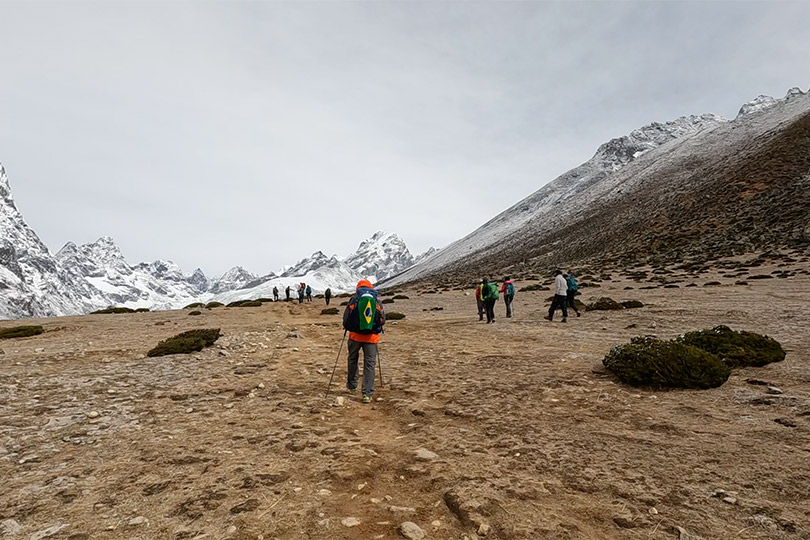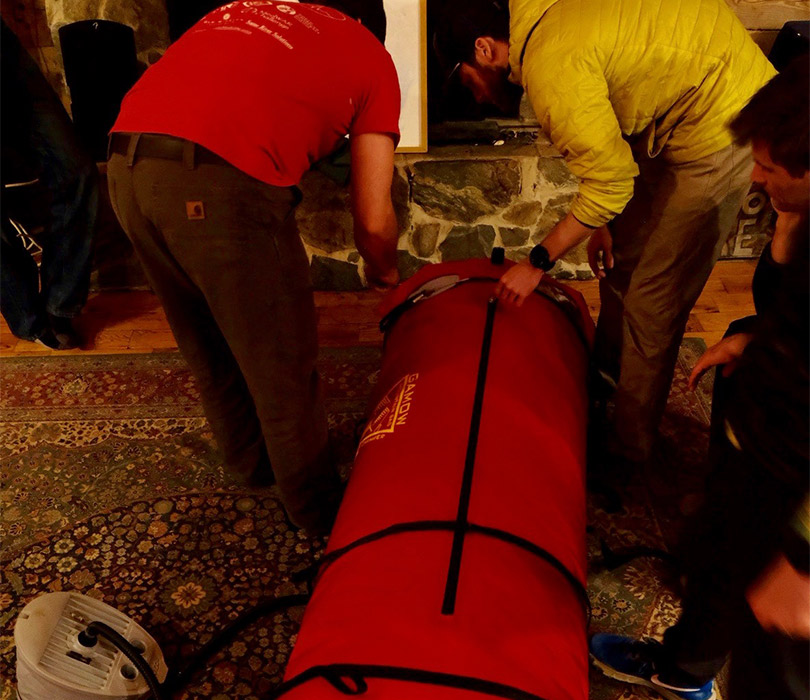Altitude Sickness or Acute Mountain Sickness (AMS) is a medical consideration faced while trekking in the Himalayas. It rarely occurs at altitudes lower than 2,800m/9,186 ft., and only minor symptoms occur below 3,000m/9842ft. The sickness occurs when the body does not adjust well to the lack of oxygen at higher altitudes.
The major cause of high altitude sickness is ascending to a height greater than 2,800m of 9000 ft. too rapidly. Giving the body little to no time to get used to the thinner air and lower oxygen levels triggers AMS.
The primary signifier of altitude sickness is a persistent headache. however, if not addressed in due time, it may develop into more complicated variations such as high-altitude cerebral edema and high-altitude pulmonary edema.
What is the Healthy Level of Oxygen to prevent High Altitude Sickness?
You must constantly monitor your oxygen level to insure that you do not suffer from high altitude sickness. The following table summarizes the healthy oxygen level in your body during high altitude trekking
| Altitude | Healthy Oxygen Level |
|---|---|
| < 1350m | 90-95% |
| < 2800m | 92-93% |
| < 3400m | 85-90% |
| < 4000m | 80-83% |
| < 5000m | 75-80% |
| < 5500m | 70-75% |
Altitude Sickness Symptoms
If you have limited experience in mountainous areas, and are not used to high altitudes, you are most vulnerable to AMS. The first symptoms begin to show 12 to 24 hours after arriving at high altitudes, and they vary upon the level of sickness you’re experiencing.

It is also important to know that the severity of the symptoms depend on personal circumstances such as your age, weight, blood pressure, and respiratory functional capacity. In addition, it depends on how fast you ascend to a higher altitude and how long you stay there. Some mild symptoms of AMS that you may experience are:
- Shortness of breath
- Dizziness and headache
- Fatigue and insomnia
- Loss of appetite
Symptoms may worsen during the night time
Some more intense symptoms could be:
- Vomiting
- Loss of appetite
- Sleeplessness
- Constant headache
- Dizziness, fatigue, lethargy, and heaviness in legs
- Light swelling of the hands, feet, and face
- Breathlessness and irregular breathing
- Infrequent urination
Altitude Sickness Prevention
Altitude sickness is mostly unavoidable but is definitely preventable. Adhering to the following measures will certainly help you prevent AMS:
- Take your time ascending. Go slow in higher altitudes.
- Avoid flying directly to high altitudes.
- Take 2-3 days to acclimatize.
- Rest every 3-4 days while ascending.
- Avoid strenuous physical activity for the first 24 hours.
- Stay hydrated at all times.
- Avoid cigarettes, caffeine, and alcohol.
- Consume a light, but high-calorie diet.

The following are some medicines that you can take to prevent AMS:
- Diamox (Acetazolamide): Start 1-2 days before your trek, and continue throughout.
- Paracetamol for the headaches
- Anti-nausea/sickness medicine (such as Avomine)
Keep in mind that previous experience with high altitude trekking does not mean you will not experience AMS. However, you may experience similar symptoms due to dehydration. Make sure to speak with your guide about your discomfort so that they can help you identify and treat your problem instantly!
All Himalayan Glacier’s guides are trained and conscious of AMS. Our experienced staff are professionals trained with wilderness first-aid (WFA), and act as medical assistants during emergencies. Overall, they are locals familiar with precautionary measures

Suggestions on Dealing with Altitude Sickness
A common misconception is expecting Altitude sickness only during climbing expeditions on some of best climbing peak in nepal such as Mera peak and Manaslu peak. But, the truth is that even on high-altitude treks like the Everest base camp trek, and the Annapurna base camp trek, you will most probably experience altitude sickness. You have to be constantly vigilant during your treks, so here are some ways to treat Altitude Sickness.
- If you can, then descend to a lower elevation.
- If not, then stop and rest where you are for at least 24 hours.
- Get some pure oxygen administered.
- Use a Gamow bag. It helps to increase the air pressure around you.
- Take over-the-counter (OTC) medications to treat headaches and dizziness.
Frequently Asked Questions
What are the first signs of altitude sickness?
Generally, the first symptoms begin to show 12-24 hours after arriving at high altitudes. The different levels of altitude sickness have different symptoms. Symptoms of mild, short-term altitude sickness are dizziness, fatigue, loss of appetite, sleeping problems, general loss of energy, and shortness of breath. Sometimes, these symptoms may be accompanied by headache, nausea, and vomiting.
Will I get altitude sickness on the trek?
Altitude sickness, also known as acute mountain sickness usually occurs when people try to ascend too quickly in altitudes beyond 2,500m (8,202ft.). It is very difficult to predict whether a trekker will get altitude sickness on the trek or not, but in the end everything depends on factors like prior exercises, previous hiking experience on high elevations, food & sleep, current hiking pace, physical fitness, medical conditions and mental health, and more.
How do I prevent altitude sickness during the trek?
Some of the tips to overcome altitude sickness, as recommended by our trekking leaders are as follows:
- Slow ascend with proper rest and enough acclimatization
- Drink plenty of water and stay hydrated at all times
- Eat sufficiently a healthy balanced diet during the entire trek and sleep well
- Avoid alcoholic beverages, cigarettes, and tobacco products on the trek
- Be head-strong and mentally prepared
- Train your body to cope with uphill hikes with enough cardiovascular or gym workouts, at least 3 months prior to the trek

A leading adventure & tour operator in the Himalayas since 1992, Himalayan Glacier Adventure & Travel Company® is the #1 guiding adventure travel company on Mount Everest Base Camp and beyond with 98% success rate. Each of our holidays is truly a tailor-made package which we design for all ages, groups, families & solo travelers.







[…] these pre-exercises would be helpful for various reasons, but importantly on how to tackle the High-Altitude-Sickness issues. These are the exercises that I did before doing my Annapurna base camp trek in […]